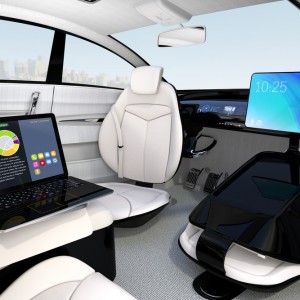Autonomous vehicles: location, opportunity and safety

Autonomous vehicles will change settlement patterns by removing the need to live close to our workplace or public transportation. This will enable people to leave cities, swapping urban life for peaceful, rural locations.
Accidents caused by drink driving and human error will become a thing of the past, greatly improving human safety – but there are significant concerns around data and cyber security (could our vehicles be ‘hacked’?) which still need to be addressed.
Location
Autonomous vehicles (or Connected and Autonomous Vehicles, CAVs) will remove the premium associated with location. Rather than focusing on driving, or being stationary in a traffic-jam, all occupants would simply be passengers, with time available to work or relax. This would have far-reaching implications on where we live.
For example, using the vehicle as a mobile workspace reduces the opportunity costs of commuting. As a result, patterns of urban agglomeration would change as proximity to towns, cities and public transport becomes less important.
The demand for urban and suburban housing would fall, whilst demand for property in more rural locations (away from railway stations) would increase with an influx of city workers. This would impact significantly on property prices with implications for a wide-range of investors.
Children and those unfit to drive through disability or age would be free of the necessity to travel with a competent adult driver, opening a new world of opportunity for these groups. For example, CAVs would relieve parents of the ‘school run’ freeing up time for more productive activities and enabling families to consider homes outside traditional catchment areas. This would also give children better access to schools which cater to their individual needs.
Leisure services and attractions could be located outside towns or cities as the population becomes more disparate across geographies. This would be a bonus for residents near nightclubs and other noisy attractions, as they could be moved to remote areas as reliance on ‘public transport’ (as we know it) becomes a thing of the past and party-goers need not worry about drink driving.
Urban planners could turn their efforts away from property development in cities and towns and focus on activities such as the transformation of abandoned car parks into leisure parks.
Always wear a seat-belt!
While drink driving becomes a thing of the past, CAVs would bring about a dramatic improvement in road safety generally, reducing the demand for emergency services and contributing to savings for the NHS.
Furthermore, as the shift to electric vehicles progresses, CO2 emissions and local air pollutants will decrease and related deaths will decrease as a result. The overall impact to the NHS is likely to be positive, but with more people living longer, there could also be considerable costs.
Cyber Security
While CAVs would increase physical safety significantly, cyber security needs careful attention.
Enormous amounts of personal data will be generated: where we work, where we live, what time we leave work, where our children go to school etc. The benefits of sharing this data, for example, with mobility providers is to enable them to customise shared and private autonomous taxis services for pick-ups and drop-offs.
The downside, if our vehicles are hacked, is that personal data might be made public, or as in the Wannacry attack, sensitive data held for ransom. More worryingly, CAVs could be high-jacked remotely and used for terrorist attacks. This needs careful attention; policy makers will need to enforce minimum-security requirements and boundaries for all connected devices in CAVs to insure society’s safety.
It’s clear that CAVs are a hugely disruptive technology. We have thought through some of the implications of their introduction and what policy makers may need to consider in the not so distance future. CE has developed a model of the European stock of cars, HGVs and buses which, when coupled with the macroeconomic E3ME model, provides a robust tool for policy assessment.
My first blog post on CAVs, which explores emerging business models can be found here.
Find out more about Cambridge Econometrics’ work on infrastructure and transport.